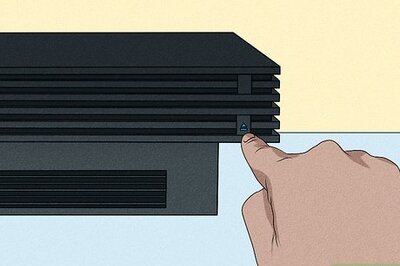
views
As happens with wordy policy documents, it can be safely assumed that the 484-page long National Education Policy (NEP) has not been read and absorbed, whether the gist or in its entirety, even by our government’s bureaucrats. Since it has been read by few but is being discussed by all—it has been one year since it was promulgated—it is time to look at its progress and the reason for its slow implementation.
Those who tried to get their arms around the implementation elephant of NEP have failed, and hence have resorted to minor tweaks. Which is why even the fundamental structural reform of the most ambitious overhaul of the Indian education system are still awaited. Implementing the NEP demands individuals with formidable, extra-special commitment, capability to plan and deliver using a systems approach.
Government policy documents do not usually come up with an implementation plan, unlike corporates. How good will a CFO be if she writes a great policy to improve margins but without an implementation plan? Most likely that CFO would be fired in a quarter if not two. But government policy makers think differently—they see themselves as big-picture visionaries; rarely do they like to get involved with myriad details of an execution plan. This is the nemesis of most policies—the lack of an execution plan. It’s only when the policy comes in the hands of an able administrator does it see its full value of execution on the ground. Most meander in search of an administrator and rarely achieve the vision.
Why Implementation is Slow
An implementation plan generally prioritizes a sequence of tasks, hires and gives responsibilities to individuals for a deadline-based execution. With the NEP this becomes even more important as it involves merging or dismantling old regulatory systems and creating new ones at both the state and union level. Changes are difficult to implement in a government when the system resists change and delays anything that incumbent administrators see as a threat to their job profiles. Please note: job profiles, not the job itself.
NEP’s implementation has been slowed by an administrative leadership that is comfortable with the status quo and does not want its gravy train to stop. In the past, mandarins at the Ministry of Education were busy with their autobiographies or promoting their children’s EdTech startups. Even the Ministry of Skill Development was for years buried under lackadaisical leadership that did not want to work, but hired PR agencies for favourable media spreads. By bringing both education and skill development under one minister, Dharmendra Pradhan, in the recent cabinet reshuffle, Prime Minister Narendra Modi has paved the way for implementing the NEP recommendations and given a clear mandate. Hopefully the two ministries will eventually be merged as they do not need to exist separately. The aspirations of the youth are linked to degrees from universities of note, not just a skill university.
From a structural point of view, implementation of NEP has to prioritize the creation of the new regulatory system. These new regulatory bodies should enable a much better functioning of the education sector for both public and private players. Currently, too many regulatory bodies with overlapping roles do not allow existing players to grow or new ones to enter the education sector. This prevents competition and innovation in a sector that determines future jobs and economic growth.
Getting out of this rut does not require a new method. The old formula for executing regulatory reforms has been tried and tested successfully several times—employ good leaders to head the regulatory bodies that must be created. These leaders will then work to clear the legislation and administrative hurdles. Until the leadership hires do not happen, implementation will be slow and challenging as nobody has their skin in the game to bring the change. Leadership change makers have to be introduced at both union and state government level.
NEP Needs Lateral Hires
No amount of “influence”, positive or negative, will lead to implementation until these changemakers are in position. Committees can discuss and debate but committees cannot execute. Only individuals with the requisite skills, commitment and authority will be able to implement. To begin with, a new Chairman of the National Higher Education Regulatory Authority (NHERA) must be employed and given the mandate, office, resources and people to build the organisation.
She will ensure that the legislation to define the role and powers of the new regulatory body is prepared and passed by Parliament. This will ensure that a model for the state level regulatory structure gets created, and funds earmarked and given to state governments. Even the current Chairman of the UGC can be asked to create the NHERA—this will give him the added incentive of creating a better organization from day one. As it is under the NEP, the various higher regulatory authorities such as the UGC and AICTE should be replaced by this one.
While the regulatory structure takes shape, the process of activating the states for school-level regulatory bodies needs to get started. A model bill like how it was done for Real Estate Regulatory Authority (RERA) needs to be prepared by the Ministry of Education for the states to implement. There are several think tanks that can help in preparing this model bill and they should be roped in, non-profit think tanks will do a better job here than the private consultancy firms.
Currently, education regulatory functions are dispersed across multiple organisations. This has created an alphabet soup of bodies that swim in murky waters. Some bodies make grants and also regulate (such as the University Grants Commission); some give accreditation (such as the National Assessment and Accreditation Council); and others control technical education (such as the All India Council for Technical Education). This structure allows a loose, convenient interpretation of rules that distorts processes and increases the friction with and between market participants. It’s no surprise that education regulatory bodies are justifiably perceived as rigid, corrupt, and feudal. They are among the last vestiges of Inspector Raj in the country.
The entry of private players is frowned upon and looked down upon by regulators; as a result, innovative EdTech players like to remain outside the purview of regulatory controls. A rule-based transparent regulatory system is proposed under NEP but is being opposed by the incumbents.
Too much is at stake and there is so much to be done in the NEP that just incumbents cannot be changemakers. New lateral hires of changemakers in the Ministries of Education and Skill is the need of the hour. Which has at least begun, with Dharmendra Pradhan and the enterprising new minister of state Rajeev Chandrasekhar running the two important ministries. Now, the new political leadership has to induct multiple changemakers to implement the NEP.
K. Yatish Rajawat is a policy analyst at www.cipp.in. He tweets @yatishrajawat. The views expressed in this article are those of the author and do not represent the stand of this publication.
Read all the Latest News, Breaking News and Union Budget 2022 updates here.


















Comments
0 comment